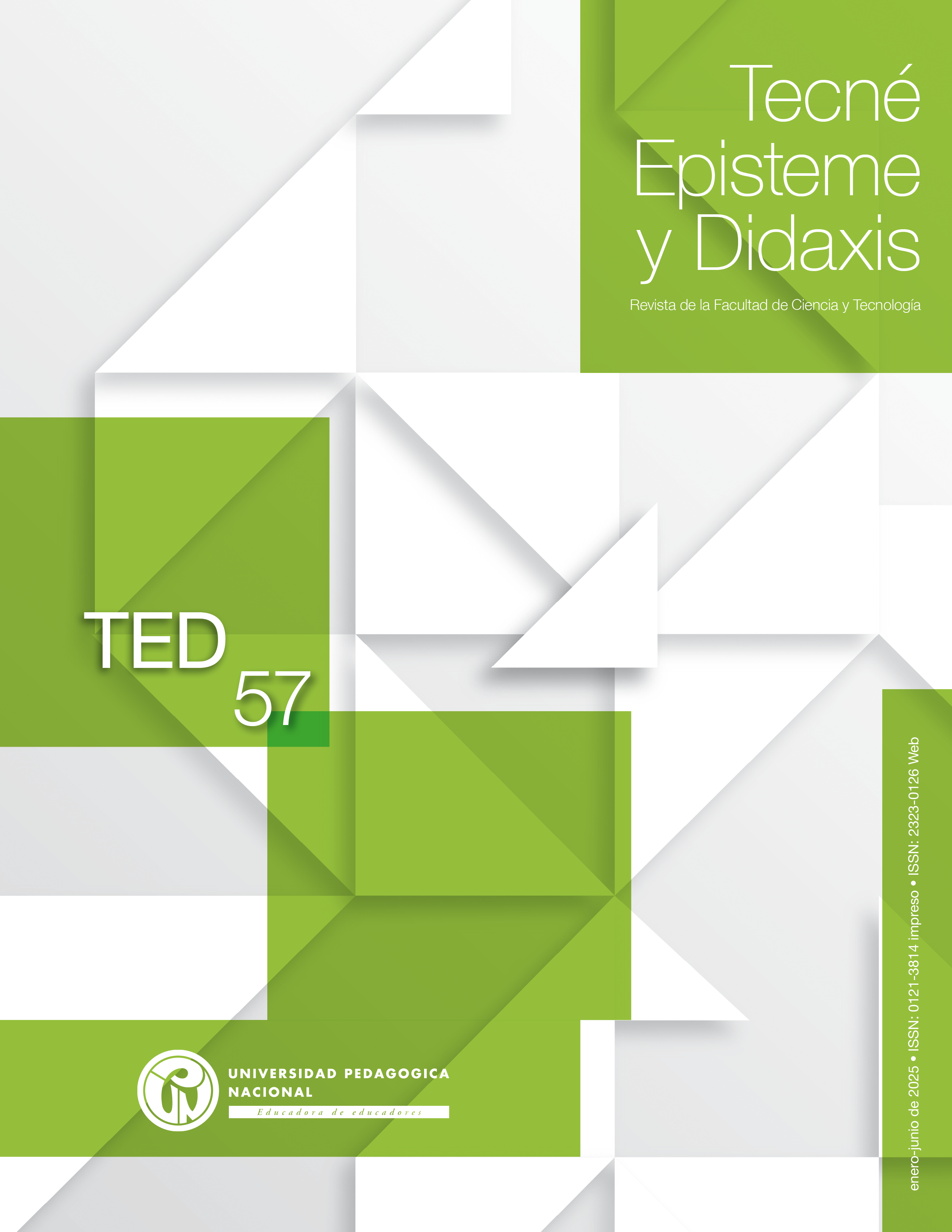El pensamiento tecnológico y sus procesos cognitivos: una revisión del estado del arte
Resumen
El presente artículo tiene como objetivo establecer un marco de referencia para la caracterización de los procesos cognitivos que subyacen al pensamiento tecnológico (pt), mediante una revisión de diversas fuentes documentales orientadas al estudio de los procesos cognitivos y a la enseñanza de la tecnología. El propósito de esta revisión fue caracterizar los procesos cognitivos que intervienen cuando se piensa tecnológicamente. En este sentido, se recopilaron, seleccionaron y organizaron diferentes fuentes documentales relacionadas con el pt y los procesos cognitivos implicados en este tipo de pensamiento. Adicionalmente, se contrastaron los diversos postulados teóricos de diferentes autores frente al tema y, finalmente, se planteó una interpretación propia de los procesos cognitivos que estructuran el pt. Los resultados de la revisión se presentan en tres apartados: procesos cognitivos asociados al pensamiento tecnológico, procesos cognitivos asociados a la solución de problemas (sp) tecnológicos y procesos cognitivos relacionados con el uso de herramientas tecnológicas. Entre los hallazgos más importantes se destaca la ubicación de los procesos de razonamiento tecnológico en el área frontoparietal dentro del lóbulo parietal inferior izquierdo y la existencia de procesos cognitivos exclusivos de la especie humana dentro del contexto tecnológico. Como conclusión, en este texto se finaliza reconociendo nueve procesos cognitivos que subyacen al pt.
Citas
Aguirre, R. y Moreira, K. (2015). Pensamiento y lenguaje. En A. Vásquez (ed.) Manual de introducción a la psicología cognitiva (pp. 147-178). Universidad de la Rioja.
Arenas, A., Ortiz, C. y Álvarez, L. (2005). Transferencia del conocimiento tecnológico al aula: estructuración el pensamiento tecnológico mediante la enseñanza del diseño. Revista uis Ingenierías, 4(2), 129-138. https://www.redalyc.org/articulo.oa?id=553756895003
Bartolo, A., Daumuller, M., Della Sala, S. y Goldenberg, G. (2007). Relationship between object-related Gestures and the Fractionated Object Knowledge System. Behavioural Neurology, 18(3),143-147. https://doi.org/10.1155/2007/241670
Buxbaum, L. y Saffran, E. (2002). Knowledge of Object Manipulation and Object Function: Dissociations in Apraxic and Nonapraxic Subject. Brain and Language, 82(2), 179-199. https://doi.org/10.1016/S0093-934X(02)00014-7
Buxbaum, L., Johnson-Frey, S. y Bartlett-Williams, M. (2005). Deficient Internal Models for Planning hand-object Interactions in Apraxia. Neuropsychologia, 43(6), 917-929. https://doi.org/10.1016/j.neuropsychologia.2004.09.006
Buxbaum, L., Schwartz, M. y Carew, T. (1997). The Role of Memory in Object Use. Cognitive Neuropsychology, 14(2), 219-254. https://doi.org/10.1080/026432997381565
Buxbaum, L., Sirigu, A., Schwartz, M. y Klatzky, R. (2003). Cognitive Representations of Hand Posture in Ideomotor Apraxia. Neuropsychologia, 41(8), 1091-1113. https://doi.org/10.1016/S0028-3932(02)00314-7
Cárdenas, E. (2013). Pensamiento tecnológico en una muestra de estudiantes del área de Tecnología e Informática. Informador Técnico, 77(2), 125-135. https://doi.org/10.23850/22565035.53
Chaquea, D. y Chamorro, C. (2013). Aproximación conceptual de técnica y tecnología en un marco de desarrollo de proyectos. Revista Nexus Comunicación, 13(1), 148-173. https://doi.org/10.25100/nc.v1i13.766
Colbourne, J., Auersperg, A., Lambert, M., Huber, L. y Völter, C. (2021). Extending the Reach of Tooling Theory: A Neurocognitive and Phylogenetic Perspective. Topics in Cognitive Science, 13(4), 548-572. https://doi.org/10.1111/tops.12554
Custer, R. (1995). Examining Dimensions of Technology. International Journal of Technology and Design Education, 5, 1-25. https://doi.org/10.1007/BF00769905
Dunbar, K. y Klahr, D. (2012). Scientific Thinking and Reasoning. The Oxford Handbook of Thinking and Reasoning (pp. 701-718). Oxford University Press. https://doi.org/10.1093/oxfordhb/9780199734689.001.0001
Edelman, G. (1992). Bright, Air, Brilliant Fire: On the Matter of the Mind. Basic Books.
Federico, G., Reynaud, E., Navarro, J., Lesourd, M., Gaujoux, V., Lamberton, F., Ibarrola, D., Cavaliere, C., Alfano, V., Aiello, M., Salvatore, M., Seguin, P., Schnebelen, D., Brandimonte, M., Rossetti, Y. y Osiurak, F. (2022). The Cortical Thickness of the Area pf of the Left Inferior Parietal Cortex Mediates technical-reasoning Skills. Scientific Reports 12(1), 11840. https://doi.org/10.1038/s41598-022-15587-8
Fugelsang, J. y Dunbar, K. (2005). Causal Thinking in Science: How Scientists and Students Interpret the Unexpected. En M. Gorman, R. Tweney, D. Gooding y A. Kincannon (eds.), Scientific and Technological Thinking (pp. 57-79). Lawrence Erlbaum Associates.
Fugelsang, J. y Dunbar, K. (2005). Scientific Thinking and Reasoning. En K. Holyoak y R. Morrison (eds.), The Cambridge Handbook of Thinking and Reasoning (pp. 705-725). Cambridge University Press.
Gagnepain, J. (1990). Du vouloir dire. Du signe, de l’outi. De Boeck Université.
Gall, D. le. (1998). Des apraxies aux atechnies. Propositions pour une ergologie clinique. De Boeck Université.
Glasser, M., Coalson, T., Robinson, E., Hacker, C., Harwell, J., Yacoub, E., Ugurbil, K., Andersson, J., Beckmann, C., Jenkinson, M., Smith, S. y Essen, D. van. (2016). A multi-modal Parcellation of Human Cerebral Cortex. Nature, 536(7615), 171-178. https://doi.org/10.1038/nature18933
Goldenberg, G. y Hagmann, S. (1998). Tool Use and Mechanical Problem Solving in Apraxia. Neuropsychologia, 36(7), 581-589. https://doi.org/10.1016/S0028-3932(97)00165-6
González, W. y Hernández, L. (2000). Tecnología y técnica: tres perspectivas. Energía y Computación, 9(1), 6-19. https://bibliotecadigital.univalle.edu.co/server/api/core/bitstreams/ea93d993-d126-45b3-bdc7-589d05c0f721/content
Halfin, H. (1973). Technology: A process Approach (tesis de doctorado). Universidad del Este de Virginia, Virginia, EE. UU.
Hartmann, K., Goldenberg, G., Daumuller, M. y Hermsdorfer, J. (2005). It Takes the Whole Brain to Make a Cup of Coffee: the Neuropsychology of Naturalistic Actions Involving Technical Devices. Neuropsychologia, 43(4), 625-637. https://doi.org/10.1016/j.neuropsychologia.2004.07.015
Hill, R. (1997). The Design of an Instrument to Assess Problem Solving Activities in Technology Education. Journal of Technology Education, 9(1), 31-46. https://doi.org/10.21061/jte.v9i1.a.3
Hill, R. y Wicklein, R. (1999). A Factor Analysis of Primary Mental Processes for Technological Problem Solving. Journal of Industrial Teacher Education, 36(2), 87-100. https://scholar.lib.vt.edu/ejournals/JITE/v36n2/hill.html
Hodges, J., Bozeat, S., Lambon-Ralph, M., Patterson, K. y Spatt, J. (2000). The Role of Knowledge in Object Use: Evidence from Semantic Dementia. Brain, 123(9), 1913-1925. https://doi.org/10.1093/brain/123.9.1913
Hodges, J., Spatt, J. y Patterson, K. (1999). What and How: Evidence for the Dissociation of Object Knowledge and Mechanical problem-solving Skills in the Human Brain. National Academy of Sciences of the usa, 96(16), 9444-9448. https://doi.org/10.1073/pnas.96.16.9444
Holyoak, K. y Morrison, R. (2012). Thinking and Reasoning: A Reader’s Guide. En K. Holyoak y R. Morrison (eds.), The Oxford Handbook of Thinking and Reasoning (pp. 1-7). Oxford University Press. https://doi.org/10.1093/OXFORDHB/9780199734689.013.0001
Hund, E. (1997). Nature vs. Nature: The Feeling of vuja de. En R. Sternberg y E. Grigorenko (eds.), Intelligence, Heredity, and Environment (pp. 531-551). Cambridge University Press. https://doi.org/10.1017/CBO9781139174282.020
Jonassen, D. (2011). Supporting Problem Solving in pbl. Interdisciplinary Journal of Problem-Based Learning, 5, 95-119. https://doi.org/10.7771/1541-5015.1256
Kelley, T., Daniel, M., Brenner, C., High, B., Jon, S. y Pieper, T. (2010). Two Approaches to Engineering Design: Observations in Stem Education. Journal of Stem Teacher Education, 47(2), 5-40. https://ir.library.illinoisstate.edu/jste/vol47/iss2/4/
Lammi, M. y Becker, K. (2013). Engineering Design Thinking. Journal of Technology Education, 24(2), 55-77. https://jte-journal.org/articles/10.21061/jte.v24i2.a.5
Lawson, B. (2005). How Designers Think: The Design Process Demystified. Architectural Press.
Mangalam, M., Fragaszy, D., Wagman, J., Day, B., Kelty-Stephen, D., Bongers, R., Stout, D. y Osiurak, F. (2022). On the Psychological Origins of Tool Use. Neuroscience and Biobehavioral Reviews, 134, 104521. https://doi.org/10.1016/j.neubiorev.2022.104521
Martín, M. y Osorio, C. (2003). Educar para participar en ciencia y tecnología. Un proyecto para la difusión de la cultura científica. Revista Iberoamericana de Educación, 32, 165-210. https://doi.org/10.35362/RIE320927
McCormack, T., Hoerl, C. y Butterfi, S. (2012). Tool Use and Causal Cognition. An Introduction. En T. McCormack (ed.), Tool Use and Causal Cognition (pp. 1-17). Oxford University Press. https://doi.org/10.1093/acprof:oso/9780199571154.003.0001
Merchán, C. (2018). Orientaciones para el uso de estrategias didácticas en el desarrollo del pensamiento tecnológico. Universidad Pedagógica y Tecnológica de Colombia (uptc).
Ochipa, C., Rothi, L. y Heilman, K. (1989). Ideational Apraxia: A Deficit in Tool Selection and Use. Annals of Neurology, 25(2), 190-193. https://doi.org/10.1002/ana.410250214
Ochipa, C., Rothi, L. y Heilman, K. (1992). Conceptual Apraxia in Alzheimer’s Disease. Brain, 115(4), 1061-1071. https://doi.org/10.1093/brain/115.4.1061
Oliveira, E. de., Reynaud, E. y Osiurak, F. (2019). Roles of Technical Reasoning, Theory of Mind, Creativity, and Fluid Cognition in Cumulative Technological Culture. Human Nature, 30, 326-340. https://doi.org/10.1007/s12110-019-09349-1
Osiurak, F. (2020). The Tool Instinct. Wiley Blackwell. https://doi.org/10.1002/9781119720348
Osiurak, F. y Badets, A. (2016). Tool Use and Affordance: manipulation-based versus reasoning-based Approaches. Psychological Review, 123(5), 534-568. https://doi.org/10.1037/rev0000027
Osiurak, F. y Heinke, D. (2018). Looking for Intoolligence: A Unified Framework for the Cognitive Study of Human Tool Use and Technology. American Psychologist, 73(2), 169-185. https://doi.org/10.1037/amp0000162
Osiurak, F., Crétel, C., Uomini, N. y Bryche, C. (2021). On the Neurocognitive co-evolution of Tool Behavior and Language: Insights from the Massive Redeployment Framework. Topics in Cognitive Science, 13(4), 684-707. https://doi.org/10.1111/tops.12577
Osiurak, F., Jarry, C. y Gall, D. le. (2010). Grasping the Affordances, Understanding the Reasoning: toward a Dialectical Theory of Human Tool Use. Psychological Review, 117(2), 517-540. https://doi.org/10.1037/a0019004
Osiurak, F., Jarry, C., Allain, P., Aubin, G., Etcharry-Bouyx, F., Richard, I., Bernard, I. y Gall, D. le. (2009). Unusual Use of Objects After Unilateral Brain Damage. The Technical Reasoning Model. Cortex, 45(6), 769-783. https://doi.org/10.1016/j.cortex.2008.06.013
Osiurak, F., Lasserre, S., Arbanti, J., Brogniart, J., Bluet, A., Navarro, J. y Reynaud, E. (2021). Technical Reasoning is Important for Cumulative Technological Culture. Nature Human Behaviour, 5(12), 1643-1651. https://doi.org/10.1038/s41562-021-01159-9
Osiurak, F., Lesourd, M., Navarro, J. y Reynaud, E. (2020). Technition: When Tools Come Out of the Closet. Perspectives on Psychological Science, 15(4), 880-897. https://doi.org/10.1177/1745691620902145
Remigereau, C., Roy, A., Costini, O., Osiurak, F., Jarry, C. y Gall, D. le. (2016). Involvement of Technical Reasoning more than Functional Knowledge in Development of Tool Use in Childhood. Frontiers in Psychology, 7, 1-11. https://doi.org/10.3389/fpsyg.2016.01625
Rodríguez, A. y Maldonado, J. (2021). Causal Cognition and Skillful Tool Use. Techne: Research in Philosophy & Technology, 25(3). https://doi.org/10.5840/techne2021118148
Seung-Kwon, N. (2010). The Development of the Technological Thinking Disposition Measurement Instrument. Chungnam National.
Simpson, L. (1995). Technology, Time, and the Conversations of Modernity. Routledge. https://www.routledge.com/Technology-Time-and-the-Conversations-of-Modernity/Simpson/p/book/9780415907729
Sterelny, K. (2021). Foragers and their Tools: Risk, Technology and Complexity. Topics in Cognitive Science, 13(4), 728-749. https://doi.org/10.1111/tops.12559
Sternberg, R. (1997). Thinking Styles. Cambridge University Press.
Stout, D. (2021). The Cognitive Science of Technology. Trends in Cognitive Sciences, 25(11), 964-977. https://doi.org/10.1016/j.tics.2021.07.005
Strimel, G. (2014). Engineering Design: A Cognitive Process Approach (tesis de doctorado). Old Dominion University, Norfolk, EE. UU. https://doi.org/10.25777/zzbj-b616
Unesco. (2022). Reimaginar juntos nuestros futuros: un nuevo contrato social para la educación. Autor.
Vaesen, K. (2012). The Cognitive Bases of Human Tool Use. Behavioral and Brain Sciences, 35(4), 203-218. https://doi.org/10.1017/S0140525X11001452
Vega, M. de. (1990). Introducción a la psicología cognitiva. Alianza.
Wicklein, R. y Rojewski, J. (1999). Toward a Unified Curriculum Framework for Technology Education. Journal of Industrial Teacher Education, 36(4), 38-56. https://scholar.lib.vt.edu/ejournals/JITE/v36n4/wicklein.html
Witt, J. (2021). Tool Use Affects Spatial Perception. Topics in Cognitive Science, 13(4), 666-683. https://doi.org/10.1111/tops.12563
Zimmerman, C. y Croker, S. (2014). A Prospective Cognition Analysis of Scientific Thinking and the Implications for Teaching and Learning Science. Journal of Cognitive Education and Psychology, 13(2), 245-257. https://doi.org/10.1891/1945-8959.13.2.245
Descargas
Derechos de autor 2025 Tecné, Episteme y Didaxis: TED

Esta obra está bajo una licencia internacional Creative Commons Atribución-NoComercial 4.0.























